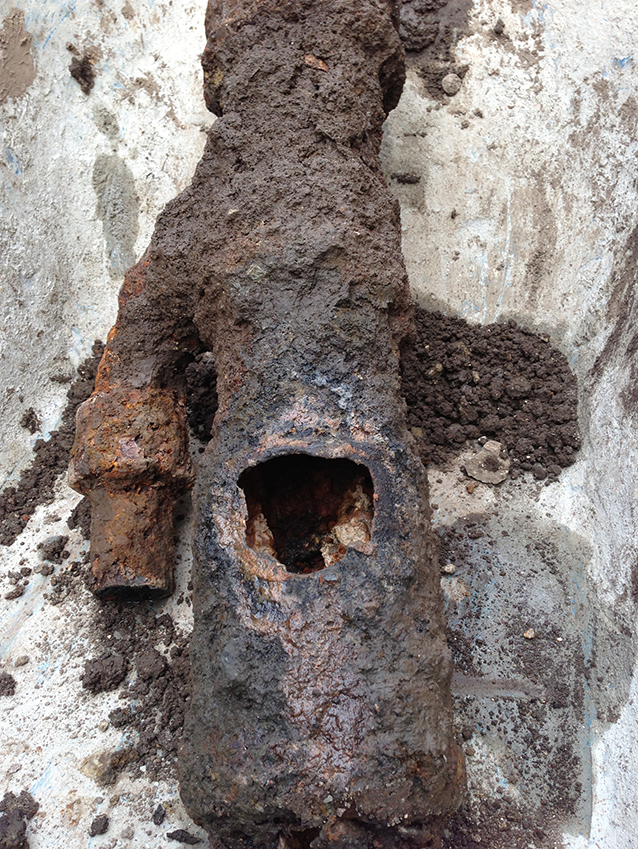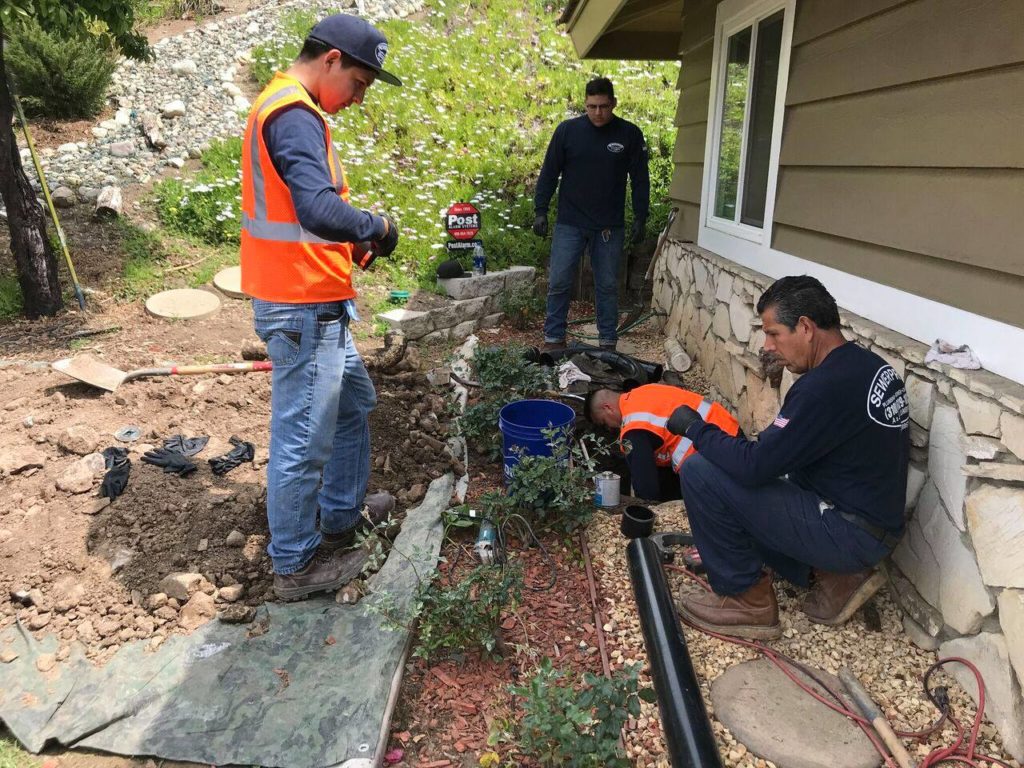Trenchless Sewer Line Repair Vs (Traditional) Sewer Repair
Trenchless Sewer Repair
The trenchless method used at Pipe Spy (pipe bursting) usually involves digging two access pits on either side of the length of a project’s sewer line—one entry pit and one exit pit where the new pipe is pulled through the existing pipe using a bursting head, breaking the old clay or cast iron away and leaving the old pipe in the ground. What is left is the new, longer lasting pipeline.
Trenchless technology was created to be more cost-efficient; these processes take less time and can often (at most single-family private residences) be executed by crews of four or five persons. Because there is less digging on a trenchless worksite on the whole, there is less chance of disruption to property landscapes and other underground utilities, making it a safer option.
The trenchless method we use at Pipe Spy is more eco-friendly and leaves a smaller carbon footprint because in its execution we use less energy, less manpower, and fewer materials; we use HDPE lines that often last 25-50 years longer than the average materials used to replace sewers. These lines are also less susceptible to environmental damage like corrosion and tree roots.
Open Trench (Traditional) Sewer Repair
The traditional method or open trench method usually involves digging up the ground around the damaged section of sewer line. After repairs are made, earth is put back into the trench.
While this may seem to be relatively inexpensive, with costs starting between $7,500-$12,000, there are some other costs associated with a process like this. First, the damage that open trenching does to your landscaping can—in rare, more complex cases—be irreversible. This could lead to major expenses such as reconfiguring or even redesigning entire yards. Trenching can be less efficient in that it can take several days and more manpower; more time and more staffing = higher costs.
Sometimes special equipment has to be brought in for trenching (particularly on larger private or commercial properties) due to city requirements and other safety measures. Special equipment = higher expense and higher costs for the customer. Acquiring additional permits could also add to your repair total.

Excavation
Traditional
After your problem has been properly diagnosed, it is time to start digging. This process is very costly if the main sewer line needs to be repaired. Many times the road, sidewalk and your yard and driveway are torn up to repair the actual problem.
Trenchless
No need for costly excavation equipment when just a few holes need to be dug to get to the pipes. Pipe lining only requires one hole, while pipe bursting may require three or more. Each of these can be dug by hand, saving a ton of money right at the start of the process.
Living Expenses
Traditional
Digging trenches in your house, yard and onto public property means your water supply is going to be shut off for the duration of the repair job. This can take anywhere from weeks to months. Your family is going to have to find another place to stay during this time, adding thousands of dollars to your total cost.
Trenchless
There is no need to leave your house at all during a trenchless repair. Your water gets shut off before work starts for the day, and is turned back on each night. This means no added costs for the homeowner.
Landscaping
Traditional
After all the repairs are done you are going to need to get your property back to normal. The contractors who dug up the road and sidewalks will be back to repair those. These costs are charged to your account. Then you are going to have to hire a landscape professional and someone to repair your driveway. These costs will run into the thousands.
Trenchless
Since there are only a few holes dug to accommodate the placement of the new pipes, there is not much extra cost for the repairs needed on your landscape. Filling these holes and replacing the grass or cement is something the homeowners can do themselves, saving thousands of dollars in the process.
Home Repairs
Traditional
If the plumbers had to come inside your home and dig a trench to replace old and damaged pipes, then the cost to repair this damage is going to cost upwards of $20,000. This includes remodeling a bathroom, replacing hard wood floors, replacing, relocating or reinstalling appliances and kitchen cabinets, and repairing walls and painting.
Trenchless
The damage from a trenchless install or repair is significantly less than a conventional repair. With only minimal holes to fill and repair, most homeowners find they can tackle these jobs with very little cash output.

Trenchless Sewer Repair Pros and Cons
Pro – Trenchless sewer line repair involves snaking a special camera through the shallowest point of your sewer line. Once your plumber identifies the blockage or damage, a new pipe made of resin is inserted to replace the damaged portion. Once this resin pipe cures, it becomes a permanent part of your line and your sewage system is ready to be used again.
Pro – A trenchless sewer repair job is usually completed within a day, which is one of the most significant advantages of this type of work. Besides minimal digging, there is little to no damage done to your property – another huge pro.
Pro – Trenchless sewer repair may be less expensive than the full cost of a traditional dig and additional cost of restoration. – resin pipes routinely last up to fifty years.
Con – The only drawback to trenchless sewer repair is that it is not always possible. Corrosion or old age can cause pipes to be unsalvageable, making a trenched sewer line repair the only option.
Trenched Sewer Repair Pros and Cons
If your existing pipes are unsalvageable, the traditional method of trenched sewer repair may be necessary. It’s imperative to consult with the experts before deciding on a course of action for your specific sewer line issue. The advantage of using the more traditional method is that even the most severe damage can be addressed thoroughly by digging into the ground. Full access makes it easier to identifying and fully address all issues. The cons can be quite overwhelming, however, since large trenches or holes will need to be dug on your property using heavy machinery and equipment, causing damage to your lawn and landscaping. It is a much more labor-intensive method as well, leading to much higher costs when you also factor in the cost of repairing the damage done to your yard and driveway.

A brief introduction to trenchless sewer repair
Trenchless sewer repair is a minimally-invasive method for fixing damaged sewer pipe that has been around since the 1970s. It was first developed in Europe and was initially used for municipal and industrial (i.e. large diameter) pipe projects.
However, it has advanced in the last 20 years or so and is now used to repair the small diameter pipes you find in single-family homes and high-rise buildings. Unlike old-school methods, trenchless sewer repair doesn’t require digging up lawns or ripping apart walls and in most cases, you’ll be able to stay in your home while the repair is going on.
It does require a construction permit though and a camera inspection before and after, to make sure that everything has been completed correctly.
Here are four of the most common types of trenchless sewer repair:
- Structural Pipe Lining or Cured-In-Place-Pipe Lining (CIPP)
- Spray Lining and Brush Coating
- Pipe Bursting
- Slip Lining
Can you use trenchless technology on a bellied line? Is it just putting a new line into the same problem? Does it need to be dug up and repaired?
Trenchless technology cannot be used on a bellied line because the sleeve will simply follow the existing pipe and end up with a belly. The line has to be dug up at the belly and repaired with a new section of pipe to correct the belly. There are other techniques for running a new line alongside the existing sewer line with directional boring or with a pneumatic gopher. Both of these technologies, however, might encounter problems with rocks or underground cables if they are in the path of the bore.